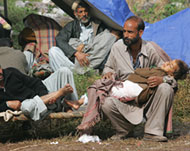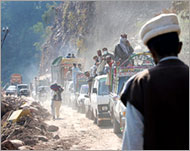Quake toll rises, more aftershocks
New casualty figures from the South Asian earthquake have pushed the toll to more than 79,000.

The new numbers come as two strong aftershocks jolted the devastated region, unleashing landslides and setting off another wave of panic among survivors who lost loved ones and homes in the 8 October disaster.
Asif Iqbal Daudzai, Information Minister for Pakistan’s North West Frontier Province, said on Wednesday that 37,958 people died in the province and at least 23,172 were injured, the vast majority of them in Mansehra district.
He said the figures were based on reports from local government and hospital officials, and that the toll was likely to rise.
The prime minister of neighbouring Pakistani-held Kashmir, Sikander Hayat Khan, said at least 40,000 people died in that region. India has reported 1360 deaths in the part of Kashmir that it controls.
The new toll by local officials is higher than the official count provided each day by the central government. That number was raised to 47,700 confirmed dead as of Wednesday, with a warning that it would rise further.
The central government count has lagged behind the local count since the early days of the disaster.
Aid not delivered
Despite brisk flights of helicopters delivering aid to quake victims in recent days, an estimated half a million survivors in Pakistan’s portion of Kashmir have yet to receive help since the 7.6-magnitude quake struck on 8 October.
 |
|
Thousands desperately need |
Thousands desperately need medical care.
The problem is worst in the estimated 1000 settlements outside the main cities and towns, said regional UN disaster coordinator Rob Holden.
“Many people out there we are not going to get to in time,” Holden said. “Some people who have injuries don’t have a chance of survival.”
Many of the 250 injured people flown by helicopter into the regional hub of Muzaffarabad on Tuesday were being attended by a qualified medic for the first time since the quake, Holden said.
Rates of infection and gangrene are rising, leaving amputation the only option in an increasing number of cases.
“One of the key factors for us is time – that’s a massive pressure on us,” he said.
Relief work slowed
Wednesday morning’s 5.8-magnitude aftershock struck 129km north of Islamabad, near the epicentre of the main quake, according to the US National Earthquake Centre in Colorado.
 |
|
The first aftershock caused a |
It was followed by another in the same area about 45 minutes later that registered 5.6 on the Richter scale.
The first aftershock caused a landslide in Balakot, one of the cities hardest hit by the initial quake.
Debris covered the road to nearby Mansehra, but it was quickly cleared, said Pakistani Army Lieutenant-Colonel Saeed Iqbal, who is in charge of the relief efforts in the area.
A landslide also blocked a road out of Muzaffarabad, the capital of Pakistani Kashmir, but it was expected to be cleared later in the day, said Ali Hassan, an engineer leading a road-clearing team.
Iqbal said that the aftershock was “very heavy” and that he saw dust rising from the Kaghan Valley north of Balakot, possibly indicating an additional landslide.
He said he had no immediate reports from his 60 teams of soldiers that were taking in relief goods in the vicinity and added: “I am concerned.”
More expected
Hundreds of aftershocks have struck the region since the 8 October quake.
 |
|
Balakot survivors are scavenging |
“They’re not over,” said Waverly Person, a seismologist at the US quake centre. “For a shallow-depth earthquake like this they go on, sometimes for a year.”
In Balakot, villagers were scavenging for food, clothes or building material.
“We need help,” said resident Basim Qassir. “There’s been deliveries, but it’s just not enough.”
While bad weather halted helicopter-borne deliveries over the weekend, Pakistani and US military helicopters delivered aid at a brisk pace on Tuesday to Muzaffarabad.
Indian help
Holden said more international medical teams were on the ground, fanning out to outlying regions to deal with the injured and provide preventive care.
 |
|
Most areas still lack healthcare |
Still, most areas lacked any form of healthcare and also needed food, water and shelter, he said.
India was considering Pakistan’s proposal to help quake victims in Kashmir by allowing residents to cross the frontier that divides the disputed territory between them – the latest sign of cooperation between the nuclear rivals since this month’s disaster.
India, which has sent quake relief supplies to Pakistan, hailed the plan but said it was awaiting details.
New Delhi earlier had offered helicopters to assist in relief missions, but turned down a Pakistani suggestion that it send military helicopters without crews.